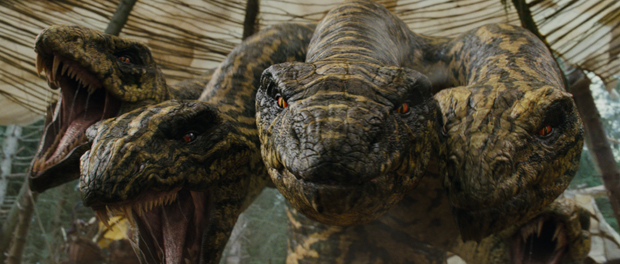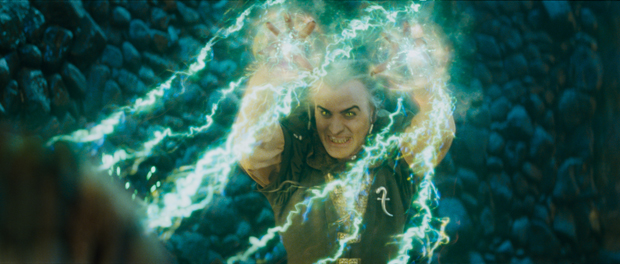McGee’s team created the concept art for the creature. “It’s a 35-foot high hand covered in lizard heads – basically a hydra,” says Ben White, “Framestore Concept Artists designed the creature in 2d and the modeling team worked well to interpret that into a 3 dimensional form and figure out the final design. Once it was approved, the director asked Mike McGee to design the fight itself. Working with the storyboard artist, McGee blocked it out and it was tweaked and approved by Green. On-set pre-viz allowed the actors to see where the creature would be relative to themselves.” Eye lines were occasionally tricky for a creature of this height. The Framestore team first had to source a pole with a ball on the end of it 35ft long – and then figure out how to operate it…

The post production work on the creature was facilitated by the pre-viz work. “We already had the animatic,” explains White, “So when we started working on the tracked material we were very clear on what was what in terms of blocking. Our Rigging team is amazing and has a pretty evolved set of tools, so building and rigging the creature was relatively straightforward. The lighting for the sequence was done in Renderman using fRibGen – our lighting and shading toolset. The lighting in the arena was very soft and diffuse, which can be a challenge. To match this feel in CG Rachel Williams, our lighting lead, used large-area lights and indirect illumination as well as HDRI contribution to get the final look.” As the battle progresses, the fingers/heads of the creature get cut off one by one, generating gallons of gore. Says White, “That was a combination of digital blood, simulated by the FX team in Houdini, and some practical elements. We also did a wet blood pass on the creature itself so that, as each of the heads gets cut off, a comp could reveal the blood over time.”
Once defeated, Marteetee – the creature’s manipulator - falls face first into the goop, and in a final comedic grace-note, his face appears pushing up from the ground, an effect achieved via F-bounce, Framestore’s in-house rigid-body dynamics tool.
Flipping the Bird
Simon, the comedy sidekick mechanical bird, was a reference to Bubo, the mechanical owl who appeared in the original Clash of the Titans. A practical animatronic bird was created for static shots, and the Framestore team were charged with getting it up in the air. “The practical model’s wings did not fully open,” notes White, “So we had to work out the virtual mechanics of getting them open and flapping. Digital Modeller Ronan Carr Fanning did a beautiful job of inventing the mechanics of the bird – we looked at old clock parts, for example – making sure that we ended up with something that didn’t look too hi-tech. For lighting we used Renderman, with Alan Woods creating the main look-dev, he and Paul Bielby doing the main work on shader writing, and Bielby adding some energy conservation properties to the metal shaders that gave them a very nice look.”
An interesting technical aspect of the development of Simon arose through the initial plan of the creative team to make the bird’s movement look like genuine stop-motion animation i.e. slightly creaky, jerky and a little unconvincing. The team gradually realised, however, that working with something created in GG – with its attendant level of detail and polish – made it extremely difficult to animate in a way that looked like stop-motion without it simply appearing to be badly animated. To make it look bad was more challenging than making it look good, in other words, and the idea was finally shelved.
Magic, Mattes and Malevolent Moons
Magic is used by many characters in Your Highness, and the Framestore team worked hard to develop the concept looks for these effects. “It obviously wasn’t going to be the ‘serious’ magic that you see in a Harry Potter film,” says McGee, “And there was also a desire to reflect the sort of effects you’d have seen in the films that inspired the project.” Working in both Maya and Houdini , dozens of man-hours of development and tweaking result in as splendid an array of glowing plasma balls, smoke clouds coming off hands, lightning bolts and waves of electricity as you could ask for.

Matte painting was used throughout to add verisimilitude – most notably in a gorgeous pan across a huge medieval mining town, full of grimy life. The film’s climax takes place at Leezar’s castle – a 200ft high phallic edifice of evil. This was – needless to say – a CG creation for its exterior appearances. Inside, Leezar’s evil scheme requires a gigantic sliding roof and a channeling of the mystical powers of two moons. Roof, moons and channeling were all handed over to Rob Duncan and the Framestore team for a suitably spectacular finish.
With Framestore in place during the developmental stage of the script, the production clearly felt able to trust the company implicitly. “Although editorial was in LA, they didn’t once come across to see the shots,” McGee comments, “Rob Duncan and I went out there twice to editorial screenings, we’d upload the work overnight and then conference the next day. It made the whole process very smooth.” And the aforementioned digital todger? It’s best you see it for yourself – no bull!
On the Spot Video:
Bulletproof Outlaws
News Letter
Latest News
- Zombies Get The motion504 Treatment In New Chiller Promo For “Remains” Thriller
- Insomniac Games Uses Autodesk Software Suite to Up the Ante for ‘Resistance 3’
- Pixomondo Leads VFX For Martin Scorsese’s Hugo
- Stereobank Announces the Addition of Super Slow Motion 3D Footage
- BIGSMACK Creates Brand Campaign For National Geographic International
- House of Moves Develops Eye Tracking Process for Film and Game Animation
- Vicon House of Moves Captures Crash Test Performance for Lexus "Light" Commercial
- Tag Games Uses Autodesk 3ds Max for "Funpark Friends" 3D Mobile Game
- Brickyard VFX Creates Box Set for ESPN
- Digital Domain and Adam Berg Tap Virtual Production for Gears of War 3 "Dust to Dust"
- Brickyard VFX Helps Saatchi & Saatchi LA and 2012 Toyota Camry Do ‘Donuts’ Around Competition
Interviews
- Yash Chavan New Media Evangelist
- Sindhuja Rajamaran the youngest CEO and 2D Animator of India
- Exploring ‘Backstage Pass’ – The School of Gaming!
- ‘Toonpur Ka Superhero’ Kireet Khurana!
- Kumar Chandrasekaran, Head of Operations at Sanraa Media
- An interview with the ‘Prince of Vriksha’!
- Arun Suryawanshi – Academic Director of CANMAS
- Arunkumar Boyidapu - Lighting & Composting Artist at Sparky Animation
- Asadul Islam – Student VFX Artist
- Dominic Chander – Head of Animation at Sun Animatics
- Sabeer Ahluwalia the ‘Quantum Gabriel’!
- Anjan Cariappa an Independent Animation Consultant
- Vaseem Ashar – VFX Supervisor at ThinkingHands
- Alexander Lindner – Visual Consultant
- Kalyan Gali - Creative Head at Icronex Technologies
- Interview with Sathya Narayanan - Senior Production Coordinator at Amskray Visual Effects Studio
- Kushagra Gour – Founder and Owner of CCPRO Games

